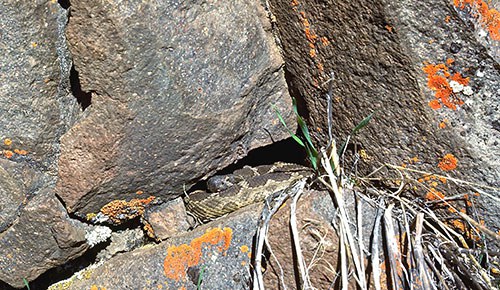By Alan St. John
As a nature writer/photographer specializing in reptiles, I'm often asked about the potential danger of rattlesnakes. With warming weather, both hikers and rattlers are out and about in Central Oregon. Most people (unless they're herpetology enthusiasts who purposefully look for turtles, lizards, and snakes) have two primary questions of concern:
Will these venomous snakes advance towards a human and attack?
What hiking locations can I choose that are NOT inhabited by rattlesnakes?
The answer for the first query will allay needless fears. No, a rattlesnake will not aggressively slither towards you, its fangs dripping venom. Take comfort in the fact that snakes of all species fear us humans, and in most circumstances will immediately crawl away and hide. So if you encounter one of these buzz-tailed serpents, merely move away from it and allow the reptile to flee in the other direction. Simple as that, no danger involved.
A defensively coiled rattler can generally strike outward no more than about half of its body length. Only the relatively small Northern Pacific Rattlesnake (Crotalus viridis oreganus) is native to Central Oregon. Despite what you've heard, the larger diamondbacks and timber rattlesnakes occur in other regions of North America. Our local species averages only about 30-36 inches in length, with rare individuals growing a bit beyond four feet. Hence, if you remain no closer than six feet, you're well outside of striking range and perfectly safe.
Once in a great while, people are indeed bitten by rattlesnakes and end up in the hospital for treatment (envenomation from our indigenous species is rarely, if ever fatal). However, considering that our area is a recreational mecca with thousands of folks annually trekking the many trails, fishing along waterways, and a myriad of other activities, it's a very uncommon event. Usually, bites happen when someone accidentally steps on an unseen rattlesnake, or while scrambling in a rocky place inadvertently places a hand on one that's hidden in a crevice. When enjoying the outdoors, just use the common sense safety measures of wearing boots that protectively cover the ankle; look first before sitting down in tall grass where a rattler might be concealed; and most importantly, don't put your hand in holes where unknown critters might lurk. More than likely, though, you'll never see a rattlesnake because they spend most of their time in hiding.
As for the second question, generally speaking, if your nature jaunt is taking place in Central Oregon's mountains above 6,000-feet elevation, you can relax with the buzz-tail paranoia. At our northerly latitudes in the Northwest, rattlesnakes are usually absent at those colder, lofty zones. For example, although a century ago rattlers reportedly occurred in the environs of Bend, they were exterminated decades ago. Therefore, it's safe to assume that upstream from Bend in the Deschutes River drainage you won't encounter rattlesnakes. Likewise for the forested heights of Newberry National Volcanic Monument, and the popular wilderness trails in the Cascade Range above Sisters and Camp Sherman. Northern Pacific rattlesnakes are denizens of lower-elevation, dry, rocky habitats in sagebrush country and sparse, sunbathed juniper-pine woodlands. Consequently, utilize the previously advised prudent precautions concerning rattlesnakes at destinations such as Smith Rock, Lake Billy Chinook, Powell Buttes, and the Prineville/Ochoco reservoirs. When hiking on Deschutes Land Trust protected lands, it's possible to occasionally see a rattlesnake at Alder Springs, Camp Polk Meadow Preserve, Coffer Ranch, Rimrock Ranch, and Whychus Canyon Preserve.

Timing can also lessen your chances of a rattlesnake encounter. Of course during the cold winter when reptiles hibernate, that possibility is zero. But even during the warmer months, choosing the time of day for your outing can make a big difference. When early spring's sunny April days initially rise above 70 degrees, rattlesnakes are just emerging from their rocky den sites, basking at the mouths of crevices. At that season, if you avoid south-facing, stony slopes before the rattlers disperse into the surrounding terrain by May, there is little risk of coming across one. Similarly, in the autumn days of late September and early October when rattlesnakes return to their dens, use the same avoidance method of steering clear of rock ledges and talus hillsides that have a southerly exposure. In between those two seasons during summer's hot weather, rattlers tend to mostly remain hidden in sheltered retreats at midday, coming out in the more moderate temperatures of the morning and evening hours, or after dark on warm July and August nights.
Probably no other native animal in our region generates as many fears, false perceptions, and tall tales as the rattlesnake. Hopefully, after reading the truth about this unique creature, hikers will stride away from the trailhead with less apprehension. Instead, perhaps there will be a tingle of excitement about treading ground that's still wild enough to harbor this icon of the American West's natural landscapes.
Other Land Trust posts by Alan St. John:
About Alan St. John
Alan St. John is a naturalist, photographer, and author of several books including Oregon's Dry Side: Exploring East of the Cascade Crest and Reptiles of the Northwest. A native Oregonian, St. John now resides in Bend. His work has appeared in National Geographic, Outdoor Photographer, Country, Natural History, The New York Times, and other periodicals. In the past he has worked as a reptile keeper at Portland's zoo, and conducted extensive herpetological field surveys for various agencies. He can be found turning over rocks and logs in search of frogs, lizards, snakes, and other critters at Land Trust Preserves.


